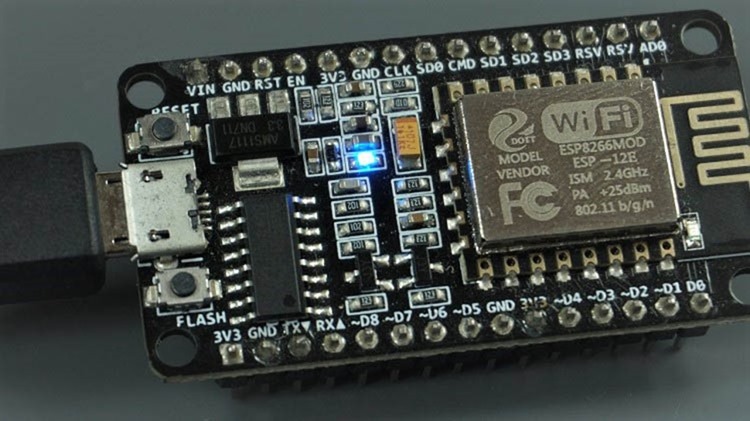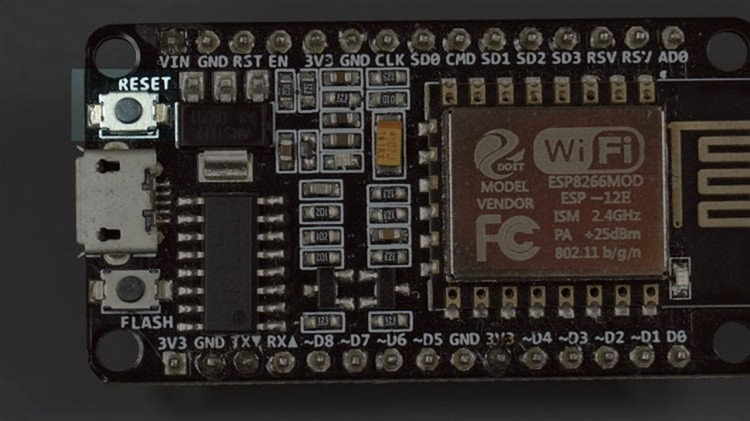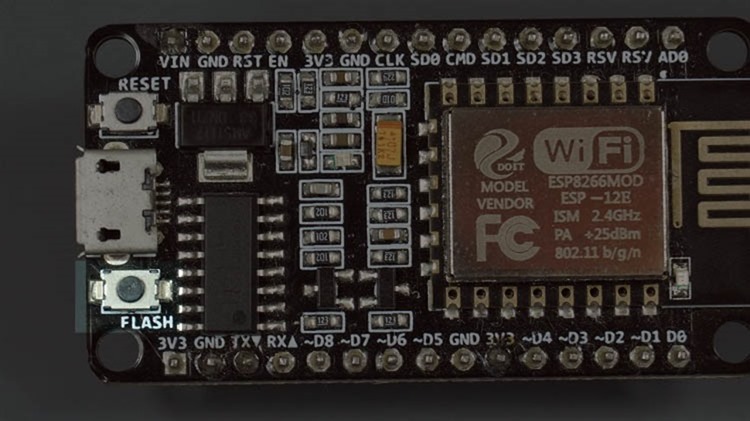This article is a guide for the ESP8266 GPIOs: pinout diagrams, their functions and how to use them.
The ESP8266 12-E chip comes with 17 GPIO pins. Not all GPIOs are exposed in all ESP8266 development boards, some GPIOs are not recommended to use, and others have very specific functions.
With this guide, you’ll learn how to properly use the ESP8266 GPIOs and avoid hours of frustration by using the most suitable pins for your projects.
We also have a guide for the ESP32 GPIOs: ESP32 Pinout Reference: Which GPIO pins should you use?
ESP8266 12-E Chip Pinout
The following figure illustrates the ESP8266 12-E chip pinout. Use this diagram if you’re using an ESP8266 bare chip in your projects.
Note: not all GPIOs are accessible in all development boards, but each specific GPIO works in the same way regardless of the development board you’re using. If you’re just getting started with the ESP8266, we recommend reading our guide: Getting Started with the ESP8266.
At the moment, there are a wide variety of development boards with the ESP8266 chip that differ in the number of accessible GPIOs, size, form factor, etc…
The most widely used ESP8266 boards are the ESP-01, ESP8266-12E NodeMCU Kit, and the Wemos D1 Mini. For a comparison of these board, you can read this guide: ESP8266 Wi-Fi Development Boards comparison.
ESP8266-01 Pinout
If you’re using an ESP8266-01 board, you can use the following GPIO diagram as a reference.
ESP8266 12-E NodeMCU Kit
The ESP8266 12-E NodeMCU kit pinout diagram is shown below.
Wemos D1 Mini Pinout
The following figure shows the WeMos D1 Mini pinout.
Download PDF with ESP8266 Pinout Diagrams
We’ve put together a handy PDF that you can download and print, so you always have the ESP8266 diagrams next to you:
Download PDF Pinout Diagrams »
ESP8266 Peripherals
The ESP8266 peripherals include:
- 17 GPIOs
- SPI
- I2C (implemented on software)
- I2S interfaces with DMA
- UART
- 10-bit ADC
Best Pins to Use – ESP8266
One important thing to notice about ESP8266 is that the GPIO number doesn’t match the label on the board silkscreen. For example, D0 corresponds to GPIO16 and D1 corresponds to GPIO5.
The following table shows the correspondence between the labels on the silkscreen and the GPIO number as well as what pins are the best to use in your projects, and which ones you need to be cautious.
The pins highlighted in green are OK to use. The ones highlighted in yellow are OK to use, but you need to pay attention because they may have unexpected behavior mainly at boot. The pins highlighted in red are not recommended to use as inputs or outputs.
Label
GPIO
Input
Output
Notes
D0
GPIO16
no interrupt
no PWM or I2C support
HIGH at boot
used to wake up from deep sleep
D1
GPIO5
OK
OK
often used as SCL (I2C)
D2
GPIO4
OK
OK
often used as SDA (I2C)
D3
GPIO0
pulled up
OK
connected to FLASH button, boot fails if pulled LOW
D4
GPIO2
pulled up
OK
HIGH at boot
connected to on-board LED, boot fails if pulled LOW
D5
GPIO14
OK
OK
SPI (SCLK)
D6
GPIO12
OK
OK
SPI (MISO)
D7
GPIO13
OK
OK
SPI (MOSI)
D8
GPIO15
pulled to GND
OK
SPI (CS)
Boot fails if pulled HIGH
RX
GPIO3
OK
RX pin
HIGH at boot
TX
GPIO1
TX pin
OK
HIGH at boot
debug output at boot, boot fails if pulled LOW
A0
ADC0
Analog Input
X
Continue reading for a more detailled and in-depth analysis of the ESP8266 GPIOs and its functions.
GPIOs connected to the Flash Chip
GPIO6 to GPIO11 are usually connected to the flash chip in ESP8266 boards. So, these pins are not recommended to use.
Pins used during Boot
The ESP8266 can be prevented from booting if some pins are pulled LOW or HIGH. The following list shows the state of the following pins on BOOT:
- GPIO16: pin is high at BOOT
- GPIO0: boot failure if pulled LOW
- GPIO2: pin is high on BOOT, boot failure if pulled LOW
- GPIO15: boot failure if pulled HIGH
- GPIO3: pin is high at BOOT
- GPIO1: pin is high at BOOT, boot failure if pulled LOW
- GPIO10: pin is high at BOOT
- GPIO9: pin is high at BOOT
Pins HIGH at Boot
There are certain pins that output a 3.3V signal when the ESP8266 boots. This may be problematic if you have relays or other peripherals connected to those GPIOs. The following GPIOs output a HIGH signal on boot:
- GPIO16
- GPIO3
- GPIO1
- GPIO10
- GPIO9
Additionally, the other GPIOs, except GPIO5 and GPIO4, can output a low-voltage signal at boot, which can be problematic if these are connected to transistors or relays. You can read this article that investigates the state and behavior of each GPIO on boot.
GPIO4 and GPIO5 are the most safe to use GPIOs if you want to operate relays.
Analog Input
The ESP8266 only supports analog reading in one GPIO. That GPIO is called ADC0 and it is usually marked on the silkscreen as A0.
The maximum input voltage of the ADC0 pin is 0 to 1V if you’re using the ESP8266 bare chip. If you’re using a development board like the ESP8266 12-E NodeMCU kit, the voltage input range is 0 to 3.3V because these boards contain an internal voltage divider.
You can learn how to use analog reading with the ESP8266 with the following guide:
On-board LED
Most of the ESP8266 development boards have a built-in LED. This LED is usually connected to GPIO2.
The LED works with inverted logic. Send a HIGH signal to turn it off, and a LOW signal to turn it on.
RST Pin
When the RST pin is pulled LOW, the ESP8266 resets. This is the same as pressing the on-board RESET button.
GPIO0
When GPIO0 is pulled LOW, it sets the ESP8266 into bootloader mode. This is the same as pressing the on-board FLASH/BOOT button.
GPIO16
GPIO16 can be used to wake up the ESP8266 from deep sleep. To wake up the ESP8266 from deep sleep, GPIO16 should be connected to the RST pin. Learn how to put the ESP8266 into deep sleep mode:
I2C
The ESP8266 doens’t have hardware I2C pins, but it can be implemented in software. So you can use any GPIOs as I2C. Usually, the following GPIOs are used as I2C pins:
- GPIO5: SCL
- GPIO4: SDA
SPI
The pins used as SPI in the ESP8266 are:
- GPIO12: MISO
- GPIO13: MOSI
- GPIO14: SCLK
- GPIO15: CS
PWM Pins
ESP8266 allows software PWM in all I/O pins: GPIO0 to GPIO15. PWM signals on ESP8266 have 10-bit resolution. Learn how to use ESP8266 PWM pins:
Interrupt Pins
The ESP8266 supports interrupts in any GPIO, except GPIO16.
Wrapping Up
We hope you’ve found this guide for the ESP8266 GPIOs useful. If you have some tips on how to use the ESP8266 GPIOs properly, you can write a comment below.
We also have a similar guide for the ESP32 GPIOs that you can read.
If you’re getting started with the ESP8266, we have some great content you might be interested in:
- Home Automation using ESP8266 (course)
- Getting Started with the ESP8266
- 30+ ESP8266 Projects and Tutorials
- ESP8266 Web Server Tutorial
- ESP32 vs ESP8266 – Pros and Cons
Thanks for reading.


